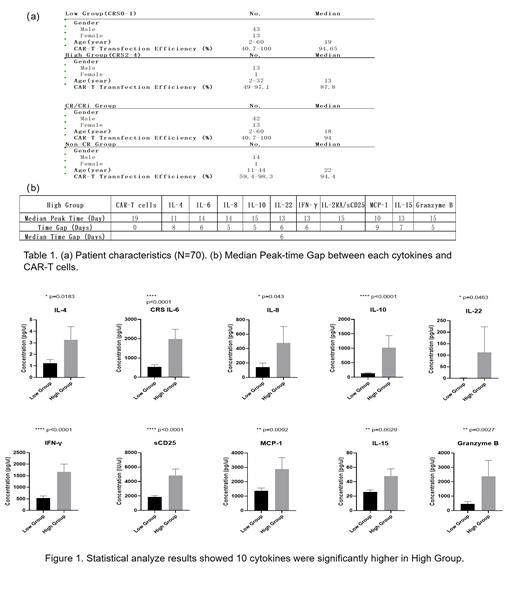Background
In the past few years, CD7 became a highly reliable marker of CAR-T therapy treating T cell acute lymphocytic leukemia(T-ALL). In this case, better understanding of CD7 CAR-T therapy on cellular level became meaningful.
Aim
To figure out the correlation of cytokines level and CAR-T expansion to CRS and outcomes of CD7 CAR-T therapy.
Methods
Peripheral blood samples were collected from 70 patients treated with CD7 CAR-T from Dec. 2020 to Nov. 2022 in Hebei Yanda Ludaopei Hospital. There were 56 males and 14 females, from 2-year old to 60 with median age 19. Based on criteria of CRS and assessment results, 70 patients were split in different groups. According to CRS level, two groups were set as low (CRS0-1, 56 of 70) group and high group (CRS2-4, 14 of 70). Due to assessment results, 55 of 70 were classified as CR/CRi group, 15 of 70 were Non-CR group.
24 Cytokines (IL-1β, IL-2, IL-4, IL-5, IL-6, IL-8, IL-10, IL-12p70, IL-17A, IL-17F, IL-22,TNFα, TNFβ, IFN-γ, IL-2RA/sCD25, MIP-1α, MCP-1, GM-CSF, IL-15, REG3a, Elafin, ST-2, Granzyme B, TNFRI) were measure with microbeads with 2 lasers 4 colour Calibur flow cytometer. CAR-T cells, target cells(CD7+ cells), T cells subsets(CD3+, CD4+, CD8+, CD8+TCM, CD8+TEM, Treg) were tested with 3 lasers 8-10 colour Canto flow cytometer. All the cellular variations were calculated by comparing value of peak-time to value of D0 which was used as baseline. Time points day0, 4, 7, 11, 14, 21, 30 were monitored after CAR-T infusion. FCM data was analyzed with Diva software. Prism 8 was used for statistic analyse.
Results
According to patient characteristics (shown in table 1a), no matter under which criteria, patients in all 4 groups had similar median age and transfection efficiency.
First of all, based on criteria of CRS level, patients were split into low group and high group(upper table 1a). CAR-T peak time was appeared significantly later(p=0.0274) in high group. Along with that, in high group, CD8+TEM(effect memory T) cells was amplified significantly more than that in low group at peak time point(p=0.0258). Clearance rates of target cells(CD7+) in low group were significantly higher(p=0.003). According to cytokine secretion levels, the level of IL-4(p=0.0183), IL-6(p<0.0001), IL-8(p=0.043), IL-10(p<0.0001), IL-22(p=0.0463), IFN-γ(p<0.0001), sCD25(<0.0001), MCP-1(p=0.0092), IL-15(p=0.0029), Granzyme B(p=0.0027) were significant higher in high group(as shown in figure 1). All median peak time of those 10 cytokines in high group were calculated, from day 10 up to day 15 after CAR-T infusion. According to the time gap between each of 10 cytokines with CAR-T expansion, MCP-1 had the largest time gap, which means MCP-1 reached peak time 9 days earlier than that of CAR-T cells. The median peak-time gap between cytokines level with CAR-T cells expansion was 6 days(showed in table 1b).
Secondly, due to criteria of assessment results of CD7 CAR-T therapies, 70 patients were classified as CR/CRi group and Non-CR group (lower table 1a). CAR-T expansion, T cell subsets variation showed no statistical difference between two groups, and only target cells (CD7+) clearance rate was significantly higher in CR group. For all 24 cytokines measured in this study showed no significant differences between both groups.
Conclusions
Base on our data, IL-4, IL-6, IL-8, IL-10, IL-15, IL-22, IFN-γ, sCD25, MCP-1, and Granzyme B were correlated to severity of CRS after CD7 CAR-T therapy. Those 10 cytokines showed positive correlation to the level of CRS, and reached peak time earlier than that of CAR-T expansion, which means all these 10 cytokines could be used as indicators to predict occurrence and severity of CRS. Concurrence time of peak expansion of CD7 CAR-T cells, and amplification of CD8+TEM cells were significantly related to CRS. For all the patients who reached complete remission or CRi, CD7+ clearance rates were higher with statistical significance. Our results proved potential indicators for CRS prediction and prognosis.
Disclosures
No relevant conflicts of interest to declare.


